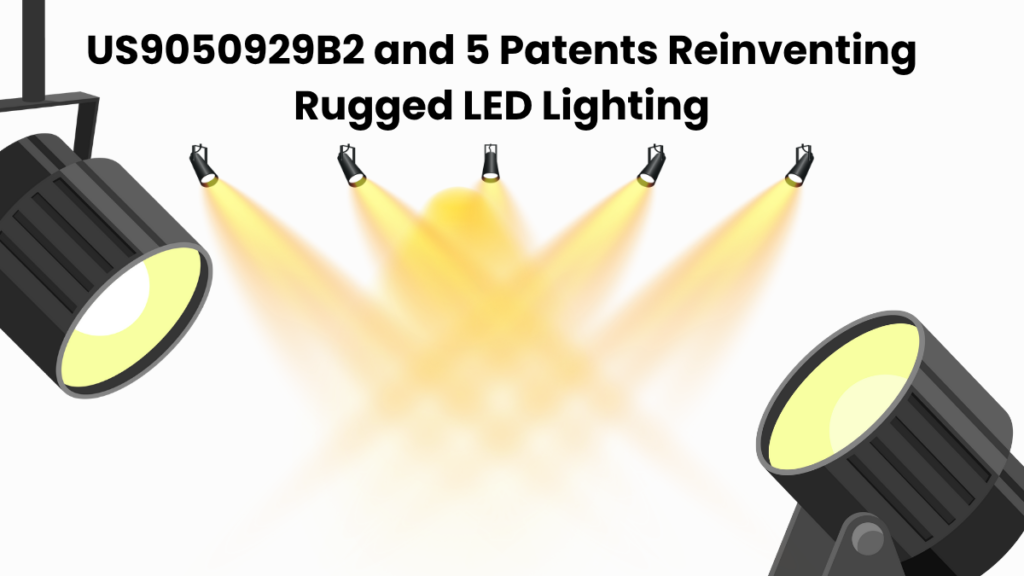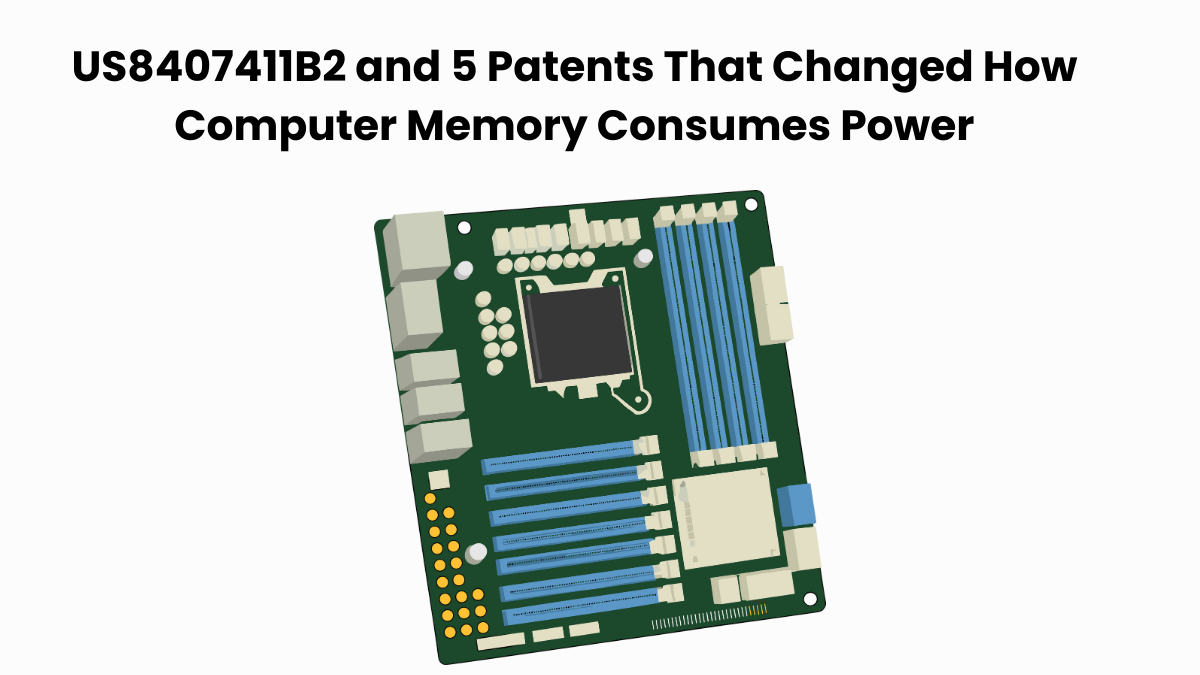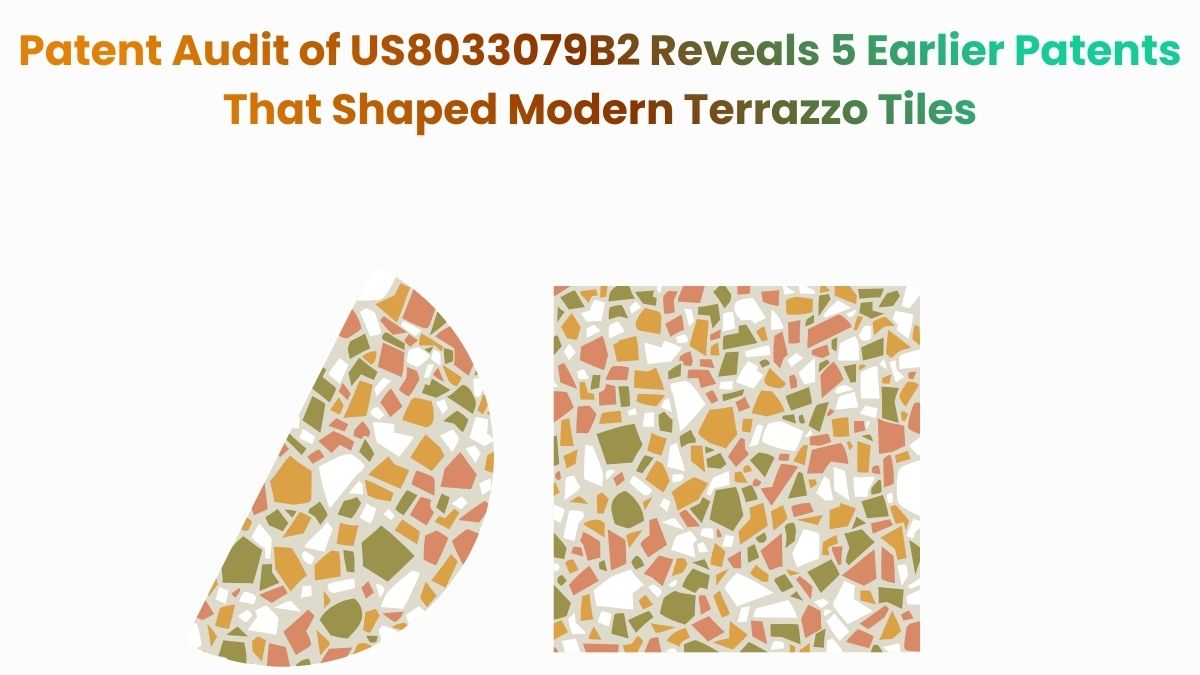US9050929B2 Under Review: 5 Patents That Could Challenge Its Claims
Every vehicle on a job site relies on its safety lights. They are the first line of visibility when conditions turn dusty, wet, or dark.
Yet traditional bulb-and-socket lights often fail at the worst possible moment. That’s the problem Patent US9050929B2 set out to solve.
This patent introduces a rugged lighting system built around waterproof, releasable LED modules. Each unit is sealed to withstand dust, impact, and moisture, while smart sensors and programmable circuits let it adapt to changing environments. The result is a whip-style safety light that lasts longer, responds faster, and is easier to maintain.
To understand how this idea fits into the broader story of industrial lighting innovation, we turned to the Global Patent Search (GPS) tool. Before exploring the related inventions it uncovered, let’s take a closer look at what US9050929B2 covers.
Technology Behind Patent US9050929B2
Patent US9050929B2 introduces a modular LED whip light designed to endure the toughest field conditions, such as vibration, moisture, and heavy impact.
Each light attaches to the whip rod through a releasable base, which means the module can be swapped quickly if it gets damaged. This small change makes a big difference for vehicles on busy worksites, where time and visibility matter most.
The light’s circuit board and lens work together to protect the LEDs and keep the beam clear. Some versions also include smart sensors that adjust brightness automatically, helping the light stay visible without wasting energy.
Overall, the patent’s design turns a simple worksite light into a durable, low-maintenance safety system built for real-world conditions.

Source – US9050929B2
Key Features Of US9050929B2
This patent introduces several innovative design elements that make the LED whip light more durable, modular, and intelligent compared to traditional lighting assemblies.
Below are the standout features:
- Liquid-Tight Base Assembly: The base connects to the whip rod with a sealed, waterproof interface to protect against moisture, dust, and vibration.
- Releasable and Replaceable LED Module: The LED light assembly is designed for quick, tool-free removal and replacement, streamlining field maintenance.
- Programmable Control Circuitry: An integrated controller allows customization of light behaviors such as flashing patterns or brightness levels.
- Ambient Light Sensor: The system can automatically adjust brightness based on environmental lighting, enhancing visibility and power efficiency.
- Directional LED Optics: Optics are built in to narrow the beam angle vertically – typically to 90° or less – for more focused illumination.
- Threaded, Waterproof Lens: The lens covering the LED assembly screws into place with a watertight seal, allowing for easy access without tools.
- High-Lumen Output with Low Power LEDs: The design includes multiple 1-watt LEDs, each delivering over 100 lumens, offering bright output while maintaining energy efficiency.
Technologies That Echo US9050929B2’s Design Philosophy
To better understand the innovation behind US9050929B2, we explored similar patents using the Global Patent Search tool. These references reveal how other inventors have tackled the challenges of waterproofing, modular LED design, and durability in rugged lighting systems.
1. TWM442445U
This Taiwanese utility model patent, published in 2012, presents a waterproof, high-efficiency LED lighting system designed for use in marine vessels, outdoor environments, and other rugged conditions.
The design combines multiple sealing components, optical enhancements, and heat management features to create a lighting unit that performs reliably even in wet or high-impact environments.
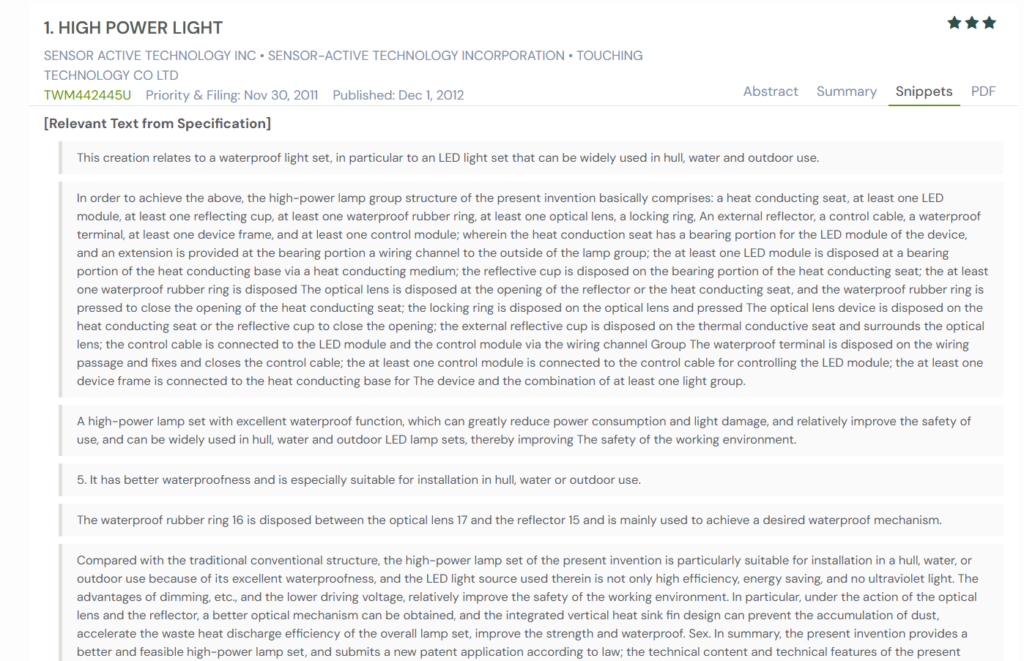
Source – GPS
Core Functional Elements
Here’s what the Taiwanese patent discloses within its lighting design:
- Heat-conductive base with integrated wiring channels: The LED module is mounted on a thermally conductive base that efficiently transfers heat away from the light source while housing the internal wiring in protected channels.
- Reflective and optical lens system: The design combines reflective surfaces and optical lenses to focus and direct the beam for higher brightness and energy efficiency.
- Mechanical locking mechanisms: The lens and housing components are secured with mechanical locks that maintain pressure on the seals, ensuring the enclosure stays waterproof even under vibration or impact.
- Integrated control module: A built-in controller manages LED brightness, power regulation, and operational modes, allowing the lighting system to adapt to different usage conditions.
- Self-contained modular frame: The lighting components are arranged within a single modular frame, creating a fully enclosed, ready-to-install unit that simplifies maintenance and assembly.
- Ruggedized structure for outdoor or marine environments: The enclosure materials and sealing design are optimized for harsh environments such as marine decks or construction sites, extending the system’s operational life.
- Cooling fins for thermal management: External fins draw heat away from the LED assembly and also help reduce dust accumulation on the surface, improving reliability over time.
Technical Overlap with US9050929B2
Both patents focus on creating durable, waterproof LED lighting assemblies designed for harsh environments. TWM442445U uses waterproof seals, optical lenses, and modular LED components, features also found in US9050929B2.
The shared emphasis on liquid-tight construction, optical control, and field-replaceable components highlights their similar approach to improving safety and performance in outdoor or vibration-prone conditions.
For a deeper look at how moisture-barrier engineering is used in fluid networks, see our analysis of US10391344B2, which applies similar principles to purge-vent assemblies in fire sprinkler systems.
2. US7182627B1
This 2007 US patent introduces a high-brightness LED lighting assembly designed for enhanced structural stability and waterproofing.
The design uses a combination of a removable soldering plate, fixing plate, transparent cover, and sealing materials to protect the LEDs and ensure secure mounting, even in outdoor or high-temperature environments.
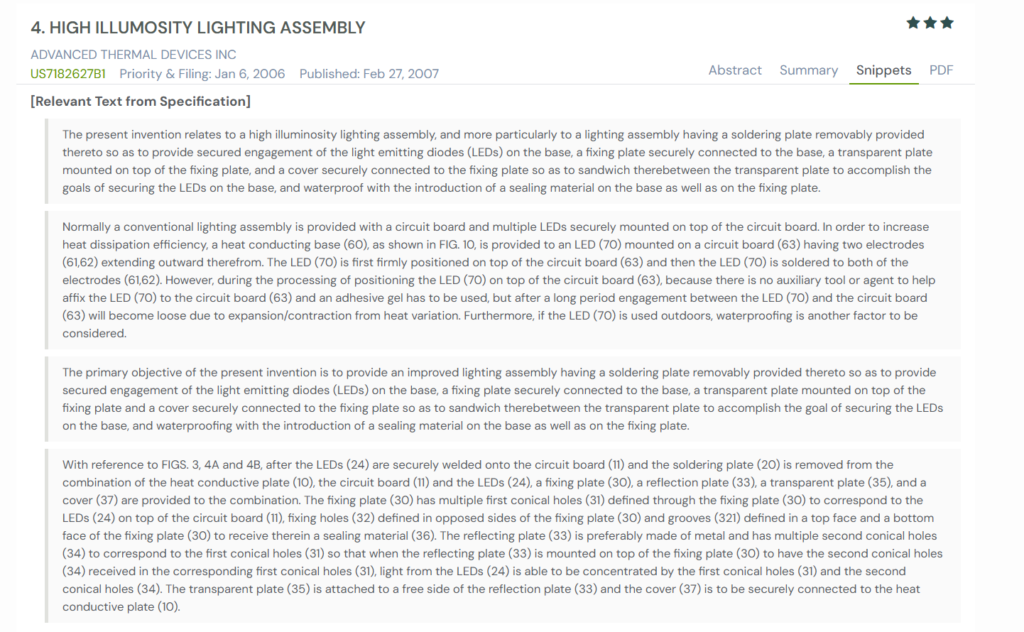
Core Functional Elements
Here’s what the US patent outlines in its lighting assembly design:
- Removable soldering plate for LED mounting: The LEDs are first secured onto a detachable soldering plate, allowing for easy alignment, inspection, or replacement before final assembly.
- Fixing plates with precision-aligned conical holes: These plates feature conical openings that guide and focus light from each LED, improving concentration and optical control.
- Integrated grooves and sealing materials: Grooves along the housing hold waterproof sealing compounds that block moisture and dust, making the assembly suitable for outdoor or high-humidity use.
- Heat-dissipating conductive base: The LED array is mounted on a thermally conductive base that efficiently disperses heat, maintaining brightness and extending component lifespan.
- Layered modular construction: The overall system is built in a stacked arrangement of plates and seals, simplifying assembly, ensuring mechanical stability, and keeping each LED firmly in place.
Technical Overlap with US9050929B2
Both patents focus on modular LED lighting systems with a strong emphasis on waterproof design, heat management, and secure LED mounting.
The use of sealing materials, layered housing components, and optics for light direction in US7182627B1 parallels the liquid-tight, replaceable LED modules and directional optics described in US9050929B2. Both aim to create robust lighting solutions suitable for demanding environments.
3. US6217203B1
Published in 2001, this 1999 patent introduces a resealable, waterproof light capsule specifically designed for boat trailer tail lights that are often submerged during launch.
Unlike fully sealed light units, this design allows for component-level replacement while maintaining a watertight seal through the use of O-rings and grooved fittings.
Core Functional Elements
Here’s what the US patent discloses within its waterproof lighting capsule design:
- Modular capsule construction: The light housing is built as a sealed capsule with a removable dome casing, allowing users to open it and replace internal components when needed.
- Precision O-ring sealing system: O-rings fitted within machined grooves maintain a consistent watertight seal, even after repeated assembly or exposure to water pressure.
- Component-level serviceability: Each lighting element can be replaced individually without discarding the entire unit, extending the overall product lifespan.
- Seal stability under stress: The enclosure is engineered to tolerate thermal expansion, vibration, and mechanical movement without compromising the seal’s integrity.
- Optimized for submerged and marine conditions: The design specifically targets trailer and boat applications, ensuring reliable moisture protection during repeated submersion.
Technical Overlap with US9050929B2
Both patents share a focus on modular lighting assemblies with waterproof enclosures.
US6217203B1 emphasizes reusability and sealing through O-rings, similar to how US9050929B2 enables tool-free replacement of LED modules with liquid-tight connections.
Each design supports easy servicing while maintaining strong environmental resistance, making them both effective solutions for rugged or moisture-prone applications.
4. US2005237755A1
This patent, published in 2005, presents a sealed LED lighting system designed for use on boat trailers. The invention focuses on protecting LEDs and electrical connections from environmental exposure such as water, salt, and debris.
The system includes a permanently sealed housing, making it suitable for rugged, submerged, or outdoor conditions.
Core Functional Elements
Here’s what the US patent application describes within its sealed LED lighting system:
- Fully sealed LED housing: The light assembly is encased within a permanently sealed enclosure that shields LEDs and circuitry from water, corrosion, and salt damage.
- Integrated wiring and LED sockets: All electrical connections are enclosed within the housing, preventing exposure to moisture and extending the overall system lifespan.
- Simple bracket-based mounting: The light can be quickly attached to trailers or boats using a basic mounting bracket, simplifying installation and replacement.
- Low-maintenance design: The sealed construction minimizes servicing needs while maintaining consistent performance in outdoor or submerged environments.
- Regulatory compliance: The system adheres to vehicle lighting and safety regulations, ensuring visibility and durability in line with transportation standards.
Technical Overlap with US9050929B2
Both inventions emphasize sealed LED assemblies that protect sensitive electrical components from moisture and contaminants.
While US2005237755A1 uses a permanently sealed container, US9050929B2 takes a more modular approach with releasable, waterproof connections.
Despite this difference, both share the goal of enhancing durability, weather resistance, and ease of installation for lighting systems used in tough environments.
5. US6595671B2
Published in 2003, this patent introduces a fully encapsulated LED lighting system built for extreme durability in marine and utility trailer environments. The design centers around a single-body construction using clear resin encapsulation, which houses the LED array, circuit board, and optical components in a solid, fluid-impermeable structure.
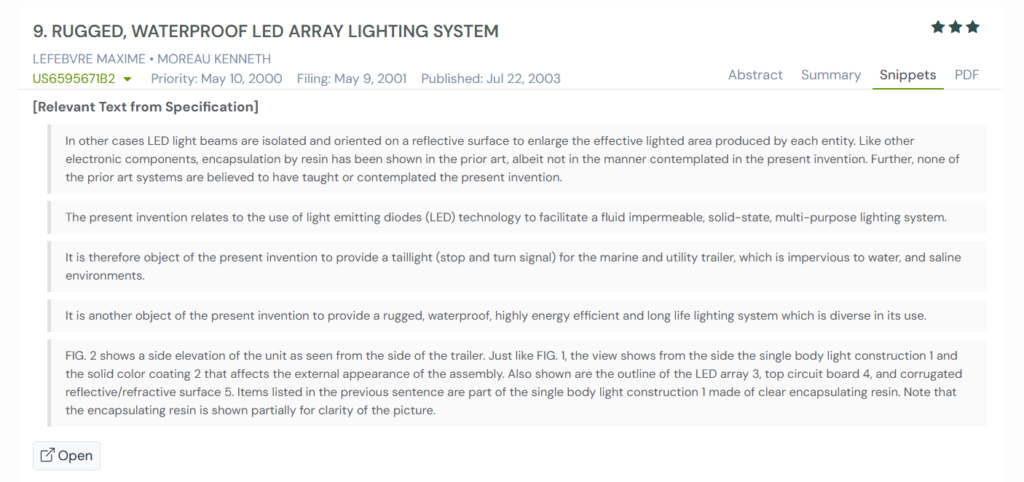
Core Functional Elements
Here’s what the US patent discloses within its encapsulated LED lighting design:
- Fully encapsulated LED array: The LEDs, circuit board, and optical elements are sealed within a single block of transparent resin, creating a solid waterproof structure that prevents any fluid ingress.
- Ruggedized construction: The housing is engineered to endure harsh outdoor, marine, and saline environments where traditional assemblies often fail.
- Integrated reflective and refractive optics: Built-in surfaces within the resin body control light direction and dispersion, enhancing brightness and visibility.
- Long-life, energy-efficient operation: The design maximizes LED efficiency and structural integrity, reducing power use while maintaining consistent output.
- Versatile application: The system is suited for taillights, signal lights, and other illumination needs on trailers, marine vessels, and utility vehicles.
- Protection of internal electronics: The resin encapsulation shields internal circuitry from vibration, corrosion, and mechanical stress, significantly reducing failure rates.
Technical Overlap with US9050929B2
Both patents prioritize durability and waterproof protection for LED lighting systems. While US6595671B2 uses full resin encapsulation to seal the entire light assembly, US9050929B2 achieves similar protection through modular components with liquid-tight seals.
Both aim to create lighting systems that are reliable, rugged, and optimized for challenging environments like trailers or industrial equipment.
How to Find Similar Lighting Patents Using Global Patent Search
When developing LED lighting systems for rugged or outdoor environments, it’s crucial to know what technologies already exist. Whether you’re working on waterproof housings, modular light assemblies, or LED circuitry with enhanced durability, the Global Patent Search tool helps uncover patents solving similar challenges.

Here’s how to use GPS effectively:
- Start with a patent number: Enter a number like US9050929B2 into the GPS tool. You can also search using terms like waterproof LED, modular light housing, or impact-resistant lighting.
- Browse highlighted snippets: Instead of lengthy claims, GPS shows curated snippets that focuses on design features like sealed connectors, lens locking systems, and heat dissipation techniques.
- Identify related inventions: The tool surfaces patents addressing similar problems, whether it’s sealing mechanisms, optical lens integration, or field-replaceable components.
- Compare design approaches:GPS helps you see how different inventors solve the same core issue, from resin encapsulation to O-ring seals and mounting systems.
- Explore across industries: Rugged lighting tech appears in transportation, marine, construction, and defense sectors. GPS connects these insights to help shape stronger designs and patent strategies.
Whether you’re designing next-gen LED assemblies or strengthening your IP portfolio, Global Patent Search helps you uncover critical prior art and stay ahead of innovation in rugged lighting systems.
Recommended Read: Here are practical tips on how to conduct a patent search faster.
Disclaimer: The information provided in this article is for informational purposes only and should not be considered legal advice. The related patent references mentioned are preliminary results from the Global Patent Search tool and do not guarantee legal significance. For a comprehensive related patent analysis, we recommend conducting a detailed search using GPS or consulting a patent attorney.

